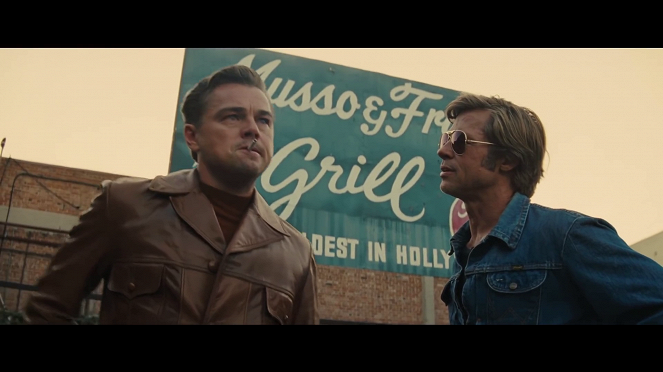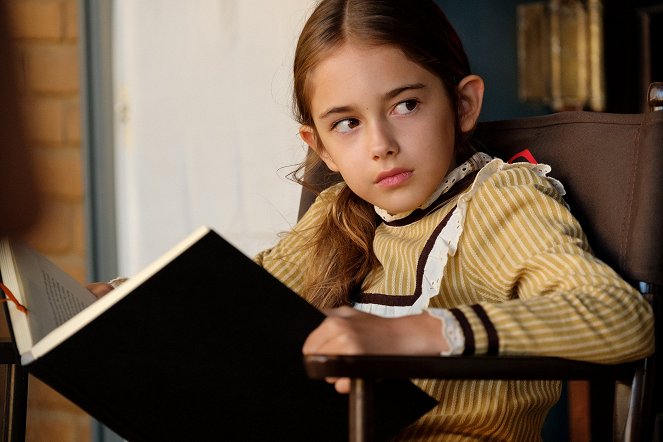Ohjaus:
Quentin TarantinoKäsikirjoitus:
Quentin TarantinoKuvaus:
Robert RichardsonNäyttelijät:
Leonardo DiCaprio, Brad Pitt, Margot Robbie, Emile Hirsch, Margaret Qualley, Timothy Olyphant, Julia Butters, Austin Butler, Dakota Fanning (lisää)Suoratoistopalvelut (4)
Juonikuvaukset(1)
Quentin Tarantinon Once Upon a Time… in Hollywood sijoittuu muutoksen kourissa olevaan vuoden 1969 Los Angelesiin. TV-tähti Rick Dalton (Leonardo DiCaprio) ja hänen pitkäaikainen sijaisnäyttelijänsä Cliff Booth (Brad Pitt) yrittävät selviytyä alalla, jota eivät enää ole tunnistaa omakseen. Käsikirjoittaja-ohjaajan yhdeksännessä elokuvassa laaja näyttelijäjoukko ja monet yhteenkietoutuvat tarinat ovat kunnianosoitus Hollywoodin kultaisen ajan viimeisille hetkille. (SF Studios Fin.)
(lisää)Videot (6)
Arvostelut (21)
As Tarantino stated in an interview with Time magazine, “I thought, we don’t need a story. They're the story.” It does not matter at all that Once Upon a Time in Hollywood is less spectacular that Tarantino’s previous films (with the exception of Jackie Brown, with which it shares a slow pace, melancholic mood and greater focus on the characters). More than on perfectly timed jokes, memorable one-liners, unexpected twists and building tension in long sequences, the film relies on the characters’ emotions (or what – like Sharon Tate – they symbolise), construction of a fictional world, the period atmosphere and the actors’ charisma. At the same time, it has an inventive three-act structure that serves well both as an evocation of the late 1960s in Los Angeles and another of Tarantino’s discussions over film/real violence and cinema as a means of living multiple lives in parallel and bringing that which has perished back to life. SPOILERS FOLLOW! From great details to greatness as a whole. From a poster-boy hero to a hero who saves actual lives. From Nazisploitation to exploitation inspired by the Manson Family. A recollection of an era when American films became more artsy (The Graduate, Easy Rider) under the influence of European cinema and more violent under the influence of the Vietnam War and turmoil on the streets (Bonnie and Clyde, The Wild Bunch). Tarantino’s use of those techniques (for example, jump cuts and long, hopeless drives as in films of the French New Wave) recalls the given period not only through music, set design and costumes, but also in formal terms. Conversely, classic Hollywood is represented by two burnt-out cowboys who, like the long-serving bosses of the major studios, do not understand young “fucking hippies” and, in the narrative that is newly taking shape, are condemned to play the roles of villains, with which they have no intention of reconciling themselves. However, the end of their era is inevitable. The protagonist of the cowboy movie that Rick reads is taken out of action roughly halfway through the story due to a hip injury. Cliff is likewise injured at the end of the film. Thus, at the end of Once Upon a Time in Hollywood, it seems that we are only halfway through Cliff and Rick’s story. Their fate is already sealed and though the conclusion of the film, while rectifying one tragedy, may seem to be a happy ending, we know that the heroes do not come out of it well (the fact that Trudi Fraser/Jodie Foster reads a biography of the, for her, brilliant Walt Disney, whose racism and anti-Semitism will begin to be addressed many years later, has a similar maliciousness). In my opinion, the key to the cohesiveness of the narrative and understanding of the story lies in the blending together or, more appositely, doubling of the individual planes of this fictional world and their relationship to actual historical events that play a significant role in shaping our expectations and emotional response. We see Sharon Tate as she was depicted in period promotional videos and photographs (the fact that someone is looking at her, amplifying her unreachability, is accentuated throughout the film, though particularly during the Playboy party, when McQueen comments on her from afar). In the only scene where Sharon herself is watching, we actually watch Margot Robbie, admiring her murdered acting colleague on the screen. Cliff, peculiarly behind the movie screen (of a drive-in cinema), represents a truer version of Rick, as he endures actual blows for Rick and does the work that makes it possible for him to exist in the world of film and television (if he hadn’t repaired the television antenna, they would not be able to watch Rick’s cameo at the FBI). The heroes exist through stories in which they also play stories told about them, which – this is essential for Tarantino’s narrative concept – we do not always know whether they are true (did Cliff kill his wife or not?). Lines delivered in the context of a role have an impact on what happens in the characters’ lives (Rick as DeCoteau tells Luke Perry’s character that he will send his man to his ranch – we subsequently see Cliff coming to Spahn Ranch). The climax of breaking down the boundaries between the real and the possible is Cliff’s encounter with a trio of murderers, whose genuineness he doubts under the influence of LSD. His dog, which is basically the only one that does not play any role, but just simply is (a dog), has no doubts and will do the lion’s share of the work in eliminating the intruders. The relationship between film and reality, the actor and his role, and violence and its representation in the media has always fascinated Tarantino, at least as much as women’s feet. This time, he plays with the transitions between one and the other perhaps even more ingeniously than ever before, and even after two viewings, I still do not feel (not by a long shot) that I would be able to grasp and uncover everything that the film has to offer. 90%
()
(vähemmän)
(lisää)
It’s Quentin Tarantino’s ninth film and nothing changed in his storytelling. It’s true that he tuned his hubris down a bit so we don’t see any 40-minute scenes with zero content, as was the case with The Hateful Eight. But it's still exactly the kind of movie you can expect from Tarantino. It‘s three hours long, with nothing happening for the first two hours, and the last 40 minutes are so full of suspense you will watch it with bated breath. Quentin strategically chose a new topic – Hollywood, but it’s actually just Pulp Fiction in a new coat. This movie seems likes Quentin Tarantino’s opus magnum. He portrays a period he obviously likes the most from Hollywood history – the Western era – and makes allusions to everything that comes to his mind. And he doesn’t care a bit if you like that era, have seen those movies or are their fan at all. He just does what he wants, and it fascinates me how much time and effort he had to invest in shooting scenes from various imaginary films, creating their posters and names. If nothing else, this makes Once Upon a Time in Hollywood a remarkable movie. Plus Leonardo DiCaprio and Brad Pitt are a pair of cool guys who can’t let Tarantino’s fans down. It still, however, seems just like a film where a group of actors meet to have some fun together, most of all Leo and Brad. You feel like you went to grab a beer with them, took a peek into their lives, and in the last part of the film you got to see some traditional Tarantino action, which is just as wild and brutal as we’re used to. In short, nothing new under the sun.
()
By far this is the best movie by the video store freak since Jackie Brown, not least because it doesn't resemble a classic Tarantino film, and because the great Quentin kind of surpassed all his bloodthirsty movies. Those who expected the typical gory carnage, got mature filmmaking, where Tarantino works sparingly with the pace, doesn't rush anywhere, caresses every scene, every line (the scenes with Sharon Tate in the cinema, or the wise little girl are the best). In the very end, however, Quentin unfortunately breaks free from his chain and in the (literally) explosive finale he shows us all that the good old morbid man is behind the camera after all, just so we don't forget. Pomo here says the finale was wonderful, for me it was the weakest link in an otherwise great film. Finally, a quick note: it would be good to have at least some awareness of who Roman Polanski and Sharon Tate are (were), and their influence on late 60s pop culture. Not like the cow in the cinema next to me who at the end said: “What was that blond girl doing there? She was pointless!” PS: Those beautiful Rick Dalton posters had the exact same graphic feel as the posters for the spaghetti westerns available on Wrong Side of the Art. Yeah, and it's too bad I'm straight, otherwise I'd hang a poster of Brad Pitt from this movie on my bedroom wall :o)
()
Hmm! Watching Once Upon a Time in Hollywood is a bit like when the proud parent of a newborn shows you an album full of pictures of their baby, gushing over it and expecting you’d gush too. But even though the photos are really nice, after a couple of pages it stops being fun, and you end up not giving a toss about the brat. Similarly, in his new film Tarantino gushes over the Hollywood of the 1960s, playing entire, often incredibly long scenes of old, mostly fictitious films that have nothing to do with anything that could be called a “plot”. And yeah, it’s nice, cute, atmospheric.. but, for someone who doesn’t care much about old Hollywood, it lasts too long. And this is not what I would love to see from Quentin. This is only masturbating over the atmosphere of the movies from the 60s, a time that is long gone. And on top of that, it’s almost without humour, which was the biggest surprise to me. The occasional efforts also fall pretty flat. For example, the scene with Bruce Lee was so incredibly stupid that I was embarrassed by it. There was a man sitting behind me in the cinema who laughed loudly for about two minutes and I just shook my head because there was really nothing to laugh about! I don’t know, this time Tarantino simply didn’t make a film for me. Only the scene at Spahn’s Ranch and the famous climax show what this film could’ve been if it’d really been “about the Manson Family”, as the reports of the new Tarantino movie said.
()
Beware of trolls. It’s a nice and fun wait for a wonderful climax that you don’t want to spoil for yourself. It is fun because of the duo of viewers’ favourites who delightfully enjoy every scene and gesture (ultimately, Brad has an even better role than Leo), and it’s nice thanks to the filming environment and nailing the cheerful colours of the carefree sixties in LA. Margot as Sharon Tate is the ultimate blonde angel, a balanced contrast to selected hippie girls from the Manson Family, who conversely are portrayed as the nastiest bunch and treated accordingly (bravo to Quentin for a courageous, fresh breeze of incorrectness in this fucked-up PC-obsessed era). However, in the dialogue and the meaning of individual scenes from the westerns of Rick Dalton (Leo’s character), as well as in the context of the movie as a whole, Tarantino’s creativity appears to be flagging. Like Franco Nero’s cameo in Django, it’s nice to have it there, but in terms of dialogue it was the weakest (or plainly just pointless) scene of the movie. Most of us consider either Basterds or (in my case) Django to be Tarantino’s masterpiece of the past decade. Do not expect Once Upon a Time to be on a par with those. Qualitatively, it is rather The Hateful Eight in an inverse, divinely lightened mood. And with a WONDERFUL climax. [Cannes]
()


